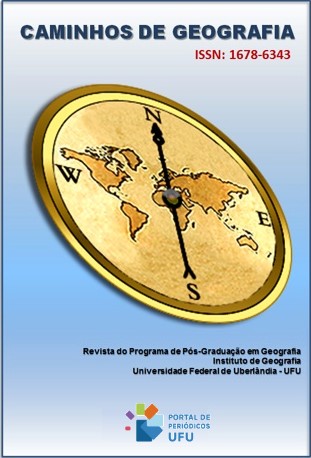ABORDAGEM ESPACIAL MULTIVARIADA APLICADA AO ESTUDO DA VARIAÇÃO DE MÉDIO PRAZO DA LINHA DE COSTA
DOI:
https://doi.org/10.14393/RCG2510170928Palavras-chave:
Linha de costa, Modelos espaciais, Variação da linha de costa de médio prazoResumo
As frentes oceânicas se caracterizam pela intensa dinâmica e vulnerabilidade, em função da ação conjunta das forçantes oceanográficas, meteorológicas e antropogênicas. Com isso, existem diversas abordagens para mensuração dessa dinâmica, destacando-se aquelas derivadas de dados de sensoriamento remoto, com base em indicadores, como a linha de costa. Esta se configura como a interface entre a área marinha e continental, podendo ser indicada pelo limite entre a área seca e úmida, e que não considera espessura ou diâmetro. Entretanto, a depender do método e dado aplicados, esses prognósticos têm maior ou menor incerteza/precisão espacial. A presente investigação, a partir de dados do satélite Landsat 5 e 8 do período de 2011 a 2018, aplicou duas abordagens (DSAS e Cassie) para estimar as variações da linha de costa da Praia do Icaraí, Ceará. Os resultados apontaram divergências entre as abordagens: o DSAS derivou um cenário de predomínio de processos erosivos e a Cassie um predomínio de progradação. Com base nas campanhas e dados de campo, bem como, na literatura, constatou-se que os dados do DSAS estão mais congruentes com a realidade local, representado uma variação líquida de -8,10 m e uma taxa de variação de -2,32 m/ano da linha de costa.
Downloads
Downloads
Publicado
Edição
Seção
Licença
Copyright (c) 2024 Filipe Maciel de Moura, Davis Pereira de Paula, Fábio Perdigão Vasconcelos, Francisco José Maciel de Moura

Este trabalho está licenciado sob uma licença Creative Commons Attribution-NonCommercial-NoDerivatives 4.0 International License.
Autores que publicam nesta revista concordam com os seguintes termos: a) Autores mantém os direitos autorais e concedem à revista o direito de primeira publicação, com o trabalho licenciado sob a Creative Commons Atribuição-NãoComercial-SemDerivações 4.0 Internacional. b) Autores têm permissão e são estimulados a publicar e distribuir seu trabalho online (ex.: em repositórios institucionais ou na sua página pessoal), já que isso pode gerar alterações produtivas, bem como aumentar o impacto e a citação do trabalho publicado. c) Em virtude de aparecerem nesta revista de acesso público, os artigos são de uso gratuito, com atribuições próprias, em aplicações educacionais e não-comerciais.











